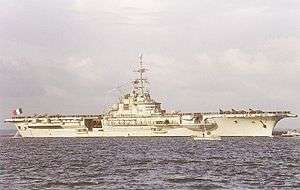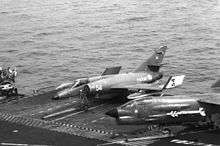French aircraft carrier Clemenceau (R98)
 | |
| History | |
|---|---|
| Name: | Clemenceau |
| Namesake: | Georges Clemenceau |
| Builder: | Brest shipyard |
| Laid down: | November 1955 |
| Launched: | 21 December 1957 |
| Commissioned: | 22 November 1961 |
| Decommissioned: | 1 October 1997 |
| Homeport: | Brest |
| Identification: | R98 |
| Nickname(s): | "Clem" |
| Fate: | Scrapped 2009-2010 |
| General characteristics | |
| Class and type: | Clemenceau-class aircraft carrier |
| Displacement: |
|
| Length: | 265 m (869 ft) |
| Beam: | 51.2 m (168 ft) |
| Draught: | 8.6 m (28 ft) |
| Installed power: |
|
| Propulsion: | 4 steam turbines |
| Speed: | 32 knots (59 km/h; 37 mph) |
| Capacity: | 582 air group personnel |
| Complement: |
|
| Sensors and processing systems: |
|
| Armament: |
|
| Aircraft carried: |
|
Clemenceau, often affectionately called "le Clem", was the French Navy's sixth aircraft carrier and the lead ship of her class. She served from 1961 to 1997. She was the second French warship to be named after Georges Clemenceau, the first being a Richelieu-class battleship laid down in 1939 but never finished. She was dismantled and recycled in 2009.[1][2]
The Clemenceau-class aircraft carriers are of conventional CATOBAR design. The landing area is 165.5 m (543 ft) long by 29.5 m (97 ft) wide; it is angled at 8 degrees off of the ship's axis. The flight deck is 265 m (869 ft) long. The forward aircraft elevator is to starboard, and the rear elevator is positioned on the deck edge to save hangar space. The forward of two 52 m (171 ft) catapults is at the bow to port, the aft catapult is on the angled landing deck. The hangar deck dimensions are 152 m (499 ft) by 22 m (72 ft)-24 m (79 ft) with 7 m (23 ft) overhead.[3]
History
The development of Clemenceau represented France's effort to produce its own class of multi-role aircraft carriers to replace the American and British ships provided at the end of World War II. The ship was a small but effective design, using elements of United States carrier design, but to a smaller scale. The vessels were given relatively heavy gun armament for their size, and some stability problems were encountered which required bulging the hull.
Clemenceau went through a major refit from September 1977 to November 1978. She was again refitted with new defensive systems from 1 September 1985 to 31 August 1987, including replacement of four of the 100 mm guns with a pair of Crotale surface-to-air missile launchers.
Clemenceau and her sister ship Foch served as the mainstays of the French fleet. During her career, Clemenceau sailed more than 1,000,000 nautical miles (2,000,000 km; 1,000,000 mi) in 3,125 days at sea, all over the world.
Missions
In 1967 Clemenceau participated in the search for the lost submarine Minerve in the Mediterranean when contact was lost 25 nautical miles (46 km; 29 mi) from returning to port at Toulon.[4] To this day no trace of Minerve has been found.[4]
In 1968 the carrier deployed to the south Pacific for French nuclear bomb testing in Polynesia including Canopus, the first French hydrogen bomb. With the deployment of the fleet, codenamed Alfa Force, the naval force present around two atolls represented more than 40% of the tonnage of the entire French navy. Clemenceau was flagship of a fleet composed of forty ships which massed more than 120,000 tons displacement.[5]
In 1974 during the Independence of Djibouti, Clemenceau deployed off the African coast in the Indian Ocean.
During the 1982–1984 Lebanese Civil War the aircraft carrier deployed in the east Mediterranean where she rotated with Foch, providing constant on-station air support to French peacekeepers.[3]
In 1987–1988 Clemenceau participated in Operation Prométhée. The ship received orders to position in the Gulf of Oman and to protect French merchant traffic in the Persian Gulf from Iranian speedboats during Iran–Iraq War. She arrived in the area on 15 August 1987. An Iranian P-3 Orion was intercepted by F-8 Crusaders deployed from this ship on a Combat Air Patrol. The Promethee battle force (Task Force 623), included Clémenceau, the mine countermeasures support ship Loire, and Durance-class tankers Meuse,Var, and Marne.

In 1990, the ship, escorted by the cruiser Colbert and the tanker Var, transported 40 helicopters (SA-341F/ -342 Gazelles, SA-330 Pumas), three Br-1050 Alizés and trucks to Iraq during Operations 'Desert Shield & Desert Storm'.[6]
Between 1993 and 1996 Clemenceau completed several tours including combat operations and air patrol over the former Yugoslavia [7] during operation 'Balbuzard' to support the UN's troops.
Disposal
On 31 December 2005, Clemenceau left Toulon to be dismantled in Alang, India despite protests over improper disposal capabilities and facilities for the toxic wastes. On 6 January 2006 the Supreme Court of India temporarily denied access to Alang.[8] After having been boarded by activists, held by Egyptian authorities, and then transiting the Suez Canal on 15 January, a court ruling by the Conseil d'État ordered Clemenceau to return to French waters.[9] Able UK based at its Greythorpe yard near Hartlepool received a new disassembly contract to use accepted practices in scrapping the ship.[10][11] The dismantling started on 18 November 2009 and the break-up was completed by the end of 2010.
General arrangement

In popular culture
- A 1985 television commercial for the Citroën Visa GTI car was shot aboard Clemenceau. A race pits the car against a Dassault Étendard IV; both continue off the end of the carrier, with the small automobile briefly keeping pace with the aircraft before plummeting into the ocean. Seconds later, though, the car triumphantly emerges, perched on the foredeck of a surfacing Agosta class submarine.
Gallery
 The ship's wheel.
The ship's wheel. Engine control panel.
Engine control panel. View of Clemenceau where the command tower and the main guns are clearly visible.
View of Clemenceau where the command tower and the main guns are clearly visible. A Super Étendard ready for launch off the flight deck (16 July 1997).
A Super Étendard ready for launch off the flight deck (16 July 1997). Super Étendards on the flight deck.
Super Étendards on the flight deck.



 Bunks on board.
Bunks on board.
Notes and references
- ↑ "New ghost ship heads to Teesside". BBC News. 8 February 2009. Retrieved 8 February 2009.
- ↑ "Ghost ships work completed". Hartlepool Mail. 20 January 2011. Retrieved 28 April 2012.
- 1 2 "Clemenceau". GlobalSecurity.org. 10 June 2013. Retrieved 24 October 2014.
- 1 2 Roche, Jean-Michel (2012). "Historique du sous-marin Minerve". netmarine.net (in French). Retrieved 6 February 2013.
- ↑ Roche, Jean-Michel. "La Marine à Mururoa". netmarine.net (in French). Retrieved 24 October 2014.
- ↑ "Porte-avions Clemenceau". ffaa.net (in French). 19 February 2011. Retrieved 24 October 2014.
- ↑ History of the CV Clemenceau
- ↑ Zubair Ahmed (2006-01-06). "Stay out, India tells toxic ship". BBC News. Retrieved 2009-03-05.
- ↑ "Chirac orders 'toxic' ship home". BBC News. 2006-01-16. Retrieved 2009-03-05.
- ↑ "Praise for 'toxic' ship scrapping". BBC News Online. 4 January 2010.
The dismantling of the former Clemenceau is a positive and pioneering operation in Europe
- ↑ "Ghost ship arrives in north-east". BBC News. 2009-02-08. Retrieved 2009-03-05.
See also
- List of aircraft carriers
- List of ship launches in 1957
- List of ship commissionings in 1961
- List of ship decommissionings in 1997
External links
| Wikimedia Commons has media related to Category:Clemenceau (R98). |
- (French) Aircraft Carrier Clemenceau on Alabordache
- Deadly Vessel : Feature on the Vessel in the Indian newsmagazine Frontline
- Victory: Toxic warship Clemenceau turned back to France! : Greenpeace View of the controversy